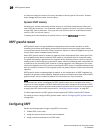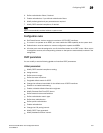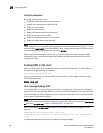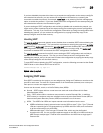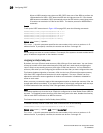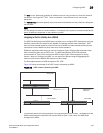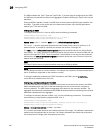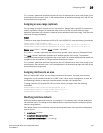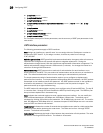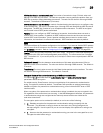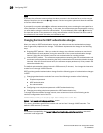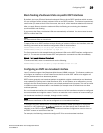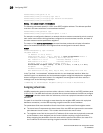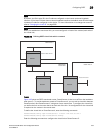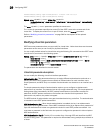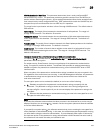
938 PowerConnect B-Series FCX Configuration Guide
53-1002266-01
Configuring OSPF
29
• ip ospf cost <num>
• ip ospf dead-interval <value>
• ip ospf hello-interval <value>
• ip ospf md5-authentication key-activation-wait-time <num> | key-id <num> [0 | 1] key
<string>
• ip ospf passive
• ip ospf priority <value>
• ip ospf retransmit-interval <value>
• ip ospf transmit-delay <value>
For a complete description of these parameters, see the summary of OSPF port parameters in the
next section.
OSPF interface parameters
The following parameters apply to OSPF interfaces.
Area: Assigns an interface to a specific area. You can assign either an IP address or number to
represent an OSPF Area ID. If you assign a number, it can be any value from 0 through
2,147,483,647.
Auth-change-wait-time: OSPF gracefully implements authentication changes to allow all routers to
implement the change and thus prevent disruption to neighbor adjacencies. During the
authentication-change interval, both the old and new authentication information is supported. The
default authentication-change interval is 300 seconds (5 minutes). You change the interval to a
value from 0 through 14400 seconds.
Authentication-key: OSPF supports three methods of authentication for each interface—none,
simple password, and MD5. Only one method of authentication can be active on an interface at a
time. The default authentication value is none, meaning no authentication is performed.
The simple password method of authentication requires you to configure an alphanumeric
password on an interface. The simple password setting takes effect immediately. All OSPF packets
transmitted on the interface contain this password. Any OSPF packet received on the interface is
checked for this password. If the password is not present, then the packet is dropped. The
password can be up to eight characters long.
The MD5 method of authentication requires you to configure a key ID and an MD5 Key. The key ID
is a number from 1 through 255 and identifies the MD5 key that is being used. The MD5 key can
be up to sixteen alphanumeric characters long.
Cost: Indicates the overhead required to send a packet across an interface. You can modify the
cost to differentiate between 100 Mbps and 1000 Mbps (1 Gbps) links. The default cost is
calculated by dividing 100 million by the bandwidth. For 10 Mbps links, the cost is 10. The cost for
both 100 Mbps and 1000 Mbps links is 1, because the speed of 1000 Mbps was not in use at the
time the OSPF cost formula was devised.
Dead-interval: Indicates the number of seconds that a neighbor router waits for a hello packet from
the current router before declaring the router down. The value can be from 1 through 65535
seconds. The default is 40 seconds.
Hello-interval: Represents the length of time between the transmission of hello packets. The value
can be from 1 through 65535 seconds. The default is 10 seconds.



